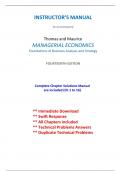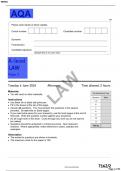INSTRUCTOR’S MANUAL
to accompany
Thomas and Maurice
MANAGERIAL ECONOMICS
Foundations of Business Analysis and Strategy
FOURTEENTH EDITION
Complete Chapter Solutions Manual
are included (Ch 1 to 16)
** Immediate Download
** Swift Response
** All Chapters included
** Technical Problems Answers
** Duplicate Technical Problems
, Table of Contents
This Instructor’s Manual accompanies Thomas and Maurice’s Managerial Economics, 14th edition. For each
chapter of the textbook, this manual supplies answers to Applied Problems, answers to Mathematical
Exercises, Homework Exercises, and answers Homework Exercises.
Chapter 1 Managers, Profits, and Markets ................................................................. 1
Chapter 2 Demand, Supply, and Market Equilibrium ................................................. 9
Chapter 3 Marginal Analysis for Optimal Decisions ................................................. 21
Chapter 4 Basic Estimation Techniques................................................................... 35
Chapter 5 Theory of Consumer Behavior ................................................................. 41
Chapter 6 Elasticity and Demand ............................................................................. 51
Chapter 7 Demand Estimation and Forecasting....................................................... 61
Chapter 8 Production and Cost in the Short Run ..................................................... 69
Chapter 9 Production and Cost in the Long Run ...................................................... 87
Chapter 10 Production and Cost Estimation ............................................................ 109
Chapter 11 Managerial Decisions in Competitive Markets ....................................... 117
Chapter 12 Managerial Decisions for Firms With Market Power .............................. 133
Chapter 13 Strategic Decision Making in Oligopoly Markets.................................... 155
Chapter 14 Advanced Pricing Techniques .............................................................. 171
Chapter 15 Decisions Under Risk and Uncertainty .................................................. 201
Chapter 16 Government Regulation of Business ..................................................... 205
, Chapter 1:
MANAGERS, PROFITS, AND MARKETS
Answers to Applied Problems
1. To say that a decision rule or process does not work in theory is to say that the answer produced by the
rule is not going to be the “correct” answer. In business decision making, managers get the “correct”
answer when their solutions are ones that lead to the greatest level of profit.
For example, it is rather easy to calculate the profit margin for a good or service and to make a
pricing decision that will maximize the profit margin on the good or service. While that may be a very
practical method of determining price, pricing to maximize profit margin does not in theory lead to the
price that maximizes the profit or value of the firm—except by accident in extremely rare
circumstances. The same can be said for making decisions that lead to the lowest possible unit or
average cost of production. Unit cost is easy to measure, and so it is useful in practice, yet unit cost is
not theoretically the correct measure of cost—that is, managers cannot, except by accident, find the
profit-maximizing price or output level by using average cost data. You will learn that the theoretically
correct cost measure is marginal cost for making profit-maximizing decisions.
Your training in managerial economics is designed to teach you the best and correct ways to make
business decisions, so that you do not settle for the numerous incorrect methods that are still used in
many businesses today. In other words, your goal should be to devise ways to make the theoretically
correct decision methods work for your company.
2.
a. Total explicit cost = $793,000 (= 555,000 + 45,000 + 28,000 + 165,000)
Total implicit cost = $190,000 (= 175,000 + 0.15 × 100,000)
Total economic cost = $983,000 (= 793,000 + 190,000)
b. Accounting profit = $177,000 (= 970,000 − 793,000)
c. Economic profit = −$13,000 (= 970,000 − 983,000)
d. The owner’s accounting profit is $13,000 less than what he could have earned in salary and return
on investment of his $100,000, that is, his economic profit is −$13,000. Thus, he would have made
$13,000 more if he had kept his job and invested his $100,000 in stocks of other businesses.
3. The $8,000 of lost income, even though not tax-deductible, is indeed part of the economic cost the
doctor incurs by going to Mexico to treat patients, and the doctor should consider this $8,000 cost in
making her decision to travel to Mexico.
4.
a. Burton’s explicit costs are $18,000 per month. His implicit costs are $20,000 per month ($15,000
+ $5,000).
b. Opportunity cost = explicit + implicit costs = $18,000 + 20,000 = $38,000 per month
c. Burton Cummings’ costs of production (=$38,000/month) exceed his revenues by $13,000 (=
38,000 −25,000). Rather than lose $13,000 per month, Burton could rent his rig (and receive
$15,000 per month) and drive trucks for another firm (and earn $5,000 per month). With this use
, of his resources he would earn $20,000 per month. Or, Burton could try his luck as a singer in a
rock band.
5. One cost of opening a tennis shop would be the forgone salary of the previous job. Given that Nadal’s
or Venus’ foregone income would be much larger than that of a university coach, their opportunity cost
would be higher.
6.
a. Linking the board of directors’ compensation to return on equity creates an incentive for
management to pursue profit maximization as a goal, thereby reducing the agency problem between
managers and shareholders.
b. Directors have better, easier, and cheaper access to information about the firm’s revenues and costs.
Shareholders are numerous and each one has only a relatively small stake in the profitability of the
firm. It is generally easier for a shareholder simply to sell its shares and reinvest in another
company.
c. Accounting profit treats the cost of using shareholder equity capital as zero, and thus CEOs and
directors will have little incentive to use equity capital efficiently. With a perceived cost of zero,
equity capital will be overused and misallocated, which will drive down the economic profit and
the value of the firm. Shareholders own the firm and they will suffer.
7.
a. Some Marriott franchises are shirking their responsibility to maintain high-quality hotels, and this
shirking damages the reputation of all Marriott franchises.
b. Poorly run franchises damage the Marriott reputation and reduce the profitability of hotels owned
by Marriott.
c. Where there is little repeat business, there is less incentive for a hotel to provide quality service.
Where there is a lot of repeat business, franchises will have an incentive to maintain quality to
attract repeat business.
8. Even though the financial arrangement with Delta and United limited the growth in SkyWest’s
economic profits in future years, the agreement decreased the risk associated with SkyWest’s profits.
In the Fortune article, one financial analyst states, “They (SkyWest) shield themselves from the factors
that lead to volatility in earnings—fuel prices, ticket prices, and load factors—and bring investors the
certainty they are looking for.” The lower level of risk reduces the risk-adjusted discount rate, and, for
a given stream of profits, the value of the SkyWest rises.
Answers to Mathematical Exercises
1.
a. PV = NCF / (1 + r )t = $1, 000 / (1.065) = $938.97
b. PV = $1, 000 / (1.065) 2 = $881.66
c. PV = $1, 000 / (1.065)3 = $827.85
2. The following spreadsheet is used to answer Parts a, b, and c of this question.
a. $22,623,062. The years 2026–2046 are hidden from view in the spreadsheet.





